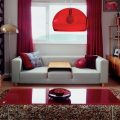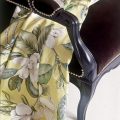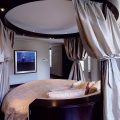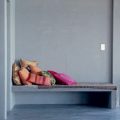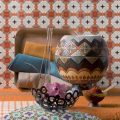The genus of tropical plants Schefflera has its name.family Araliaceae, which includes Schefflera radiata or star-leaved (Sch. actinophylla) - its homeland is New Zealand - received from the name of the famous German botanist Jacob Christian Scheffler (18th century). The genus has more than 150 species, among which in natural conditions there are shrubs, small and even large trees reaching a height of 40 m or more.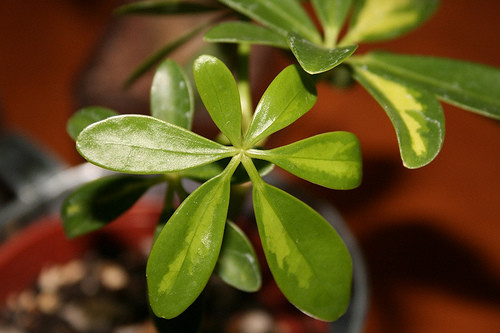 Schefflera careSchefflera radialifolia has leatheryshiny green palmately dissected leaves, consisting of 4-8 pointed leaflets (20 cm or more long, up to 5 cm wide), which emerge from one point, like the spokes of an umbrella. In room conditions, it can reach a height of 1.5-2.5 m, although in nature, trees of 4-8 m are considered typical. Schefflera has small, inconspicuous white flowers in umbrellas collected in a complex paniculate inflorescence, but in room conditions, as a rule, it does not bloom. By the way, it is thanks to the characteristic, tentacle-like inflorescences in subtropical parks that this tree was nicknamed the "octopus tree". Some experts consider Schefflera an undemanding plant to care for, but it is difficult to agree with this. It is placed in a fairly well-ventilated place and in bright diffused light (without scorching sunlight). It is acceptable, as for a shade-loving plant, to place the schefflera in a slightly darkened place; it also develops normally under artificial lighting. A pot with a low plant can be placed on a windowsill facing east, but if the plant becomes cramped there, it is moved to the floor. In summer, the schefflera can be taken out into the fresh air and placed under the protection of tall trees, or the room can be regularly ventilated. For this period, the optimal temperature for maintenance is 18-22°C. Although some gardeners consider this crop to be quite resistant to increased dry air and the effects of drafts, I believe that as a tropical plant, it should still be provided with fairly high humidity in the room and insure against drafts, and with a combination of dry air and high (24-26°C) temperature, it is necessary to spray the foliage daily (morning and evening) with soft water at room temperature. The soil is watered with the same water, avoiding over-watering. Periodically, the schefflera is given a "shower". Fertilizers are applied (once every 3 weeks) in the form of solutions, alternating organic and mineral fertilizers.
Schefflera careSchefflera radialifolia has leatheryshiny green palmately dissected leaves, consisting of 4-8 pointed leaflets (20 cm or more long, up to 5 cm wide), which emerge from one point, like the spokes of an umbrella. In room conditions, it can reach a height of 1.5-2.5 m, although in nature, trees of 4-8 m are considered typical. Schefflera has small, inconspicuous white flowers in umbrellas collected in a complex paniculate inflorescence, but in room conditions, as a rule, it does not bloom. By the way, it is thanks to the characteristic, tentacle-like inflorescences in subtropical parks that this tree was nicknamed the "octopus tree". Some experts consider Schefflera an undemanding plant to care for, but it is difficult to agree with this. It is placed in a fairly well-ventilated place and in bright diffused light (without scorching sunlight). It is acceptable, as for a shade-loving plant, to place the schefflera in a slightly darkened place; it also develops normally under artificial lighting. A pot with a low plant can be placed on a windowsill facing east, but if the plant becomes cramped there, it is moved to the floor. In summer, the schefflera can be taken out into the fresh air and placed under the protection of tall trees, or the room can be regularly ventilated. For this period, the optimal temperature for maintenance is 18-22°C. Although some gardeners consider this crop to be quite resistant to increased dry air and the effects of drafts, I believe that as a tropical plant, it should still be provided with fairly high humidity in the room and insure against drafts, and with a combination of dry air and high (24-26°C) temperature, it is necessary to spray the foliage daily (morning and evening) with soft water at room temperature. The soil is watered with the same water, avoiding over-watering. Periodically, the schefflera is given a "shower". Fertilizers are applied (once every 3 weeks) in the form of solutions, alternating organic and mineral fertilizers.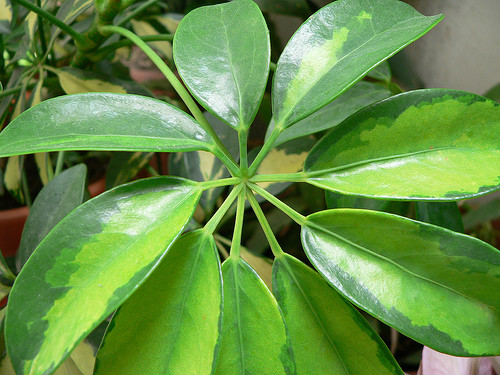 Schefflera care at homeIn winter plantrequires very good lighting; it tolerates 13-14°C, however, prolonged exposure to temperatures below 100°C may cause massive leaf fall. During this period, watering is extremely moderate (fertilizing is not allowed). It is important to keep in mind that schefflera is very sensitive to both overdrying of the soil lump and excessive moisture. Young specimens of this plant are replanted annually in the spring, while adults are replanted every 2-3 years. The soil substrate for growing schefflera should be fertile, light (well permeable). According to experts, the optimal soil mixture is made from compost and peat soil, coarse river sand (in a ratio of 3:1:1.5) or from turf, leaf, humus soil and sand (2:1:1:1). Although it should be noted that even large specimens of schefflera grow successfully in tight containers, if they are properly cared for, i.e. watered, fed and pruned in a timely manner. Since schefflera is very sensitive to excess moisture in the soil substrate, a sufficiently high (5-7 cm) drainage layer of small stones or pieces of a broken pot is necessarily arranged at the bottom of the planting container. It is important that the drain hole at the bottom, through which excess water drains, is not clogged. For successful propagation of schefflera at home with semi-lignified cuttings (7-10 cm long), taken from the middle part of the stem, you cannot do without stimulants (for example, heteroauxin or root). The cuttings are cut carefully with a sharp knife (immediately under the node), since the schefflera juice is poisonous, and excess leaves are removed. After treatment with the stimulator solution, the cuttings are planted in clean sand or a mixture of sand and peat (1:1), having previously made depressions in the substrate. Each cutting is planted up to the first leaf (then carefully press the soil around the stems). After this, the cuttings are covered with a plastic bag and provided with diffused light; it is advisable to take care of the bottom heating. After the appearance of new leaves, the plastic bag is removed, allowing the cuttings to gradually acclimatize to the environment. Rooted seedlings are transplanted into pots with a soil mixture of turf, leaf, peat soil and sand (in the ratio of 1:1:1:1.5).
Schefflera care at homeIn winter plantrequires very good lighting; it tolerates 13-14°C, however, prolonged exposure to temperatures below 100°C may cause massive leaf fall. During this period, watering is extremely moderate (fertilizing is not allowed). It is important to keep in mind that schefflera is very sensitive to both overdrying of the soil lump and excessive moisture. Young specimens of this plant are replanted annually in the spring, while adults are replanted every 2-3 years. The soil substrate for growing schefflera should be fertile, light (well permeable). According to experts, the optimal soil mixture is made from compost and peat soil, coarse river sand (in a ratio of 3:1:1.5) or from turf, leaf, humus soil and sand (2:1:1:1). Although it should be noted that even large specimens of schefflera grow successfully in tight containers, if they are properly cared for, i.e. watered, fed and pruned in a timely manner. Since schefflera is very sensitive to excess moisture in the soil substrate, a sufficiently high (5-7 cm) drainage layer of small stones or pieces of a broken pot is necessarily arranged at the bottom of the planting container. It is important that the drain hole at the bottom, through which excess water drains, is not clogged. For successful propagation of schefflera at home with semi-lignified cuttings (7-10 cm long), taken from the middle part of the stem, you cannot do without stimulants (for example, heteroauxin or root). The cuttings are cut carefully with a sharp knife (immediately under the node), since the schefflera juice is poisonous, and excess leaves are removed. After treatment with the stimulator solution, the cuttings are planted in clean sand or a mixture of sand and peat (1:1), having previously made depressions in the substrate. Each cutting is planted up to the first leaf (then carefully press the soil around the stems). After this, the cuttings are covered with a plastic bag and provided with diffused light; it is advisable to take care of the bottom heating. After the appearance of new leaves, the plastic bag is removed, allowing the cuttings to gradually acclimatize to the environment. Rooted seedlings are transplanted into pots with a soil mixture of turf, leaf, peat soil and sand (in the ratio of 1:1:1:1.5). If the florist takes advantage of the emergingretail sale of seeds, then after sowing them (in January-February) to a depth of 0.5 cm, the container is covered with glass, a temperature of 22-25°C is provided, but when shoots appear (after about 2-3 weeks) it is reduced to 18-20°C. To propagate this crop, you can try the air layering method, I was convinced of its high efficiency after visiting the large greenhouses of the giant Krasnaya Niva farm near Moscow, which reproduces a huge number of perennial indoor plants and bonsai. On the upper part of the branch (with 2-3 leaves), a cut is made a third of the stem thickness, into which a piece of thin glass is inserted (otherwise the cut will quickly "float over"). Then the stem at the cut is wrapped in wet sphagnum, which must be moistened daily. After such a month of maintenance, the branch in the damaged area produces a good root system, after which it can be separated from the mother plant. Although this method does not always work indoors, it can be tried. It is very important to properly form the shefflera, then it will become a real decoration of any indoor flower garden. For this purpose, the excessively overgrown ends of the shefflera are pinched to force the plant to bush. But it must be admitted that the shefflera does not branch very willingly. This creates difficulties in forming its crown. It is for this reason that, for greater decorativeness, some gardeners sometimes plant young or stubbornly unbranched plants 3-4 specimens in one pot, bringing their trunks as close as possible and thus obtaining the effect of an original-looking "bush". In addition, this method of preliminary planting several plants in one container eliminates the need to trim an adult plant later, which greatly reduces the decorative qualities of the latter. Of course, you can buy an already formed (sufficiently branched) specimen in stores. With its appearance, a well-developed tall bush of this beautiful decorative foliage plant with large, spectacular palmate leaves attracts the eye, decorates the room. It is equally suitable for large halls and winter gardens, reception rooms and offices of various offices, for spacious living rooms of residential premises.
If the florist takes advantage of the emergingretail sale of seeds, then after sowing them (in January-February) to a depth of 0.5 cm, the container is covered with glass, a temperature of 22-25°C is provided, but when shoots appear (after about 2-3 weeks) it is reduced to 18-20°C. To propagate this crop, you can try the air layering method, I was convinced of its high efficiency after visiting the large greenhouses of the giant Krasnaya Niva farm near Moscow, which reproduces a huge number of perennial indoor plants and bonsai. On the upper part of the branch (with 2-3 leaves), a cut is made a third of the stem thickness, into which a piece of thin glass is inserted (otherwise the cut will quickly "float over"). Then the stem at the cut is wrapped in wet sphagnum, which must be moistened daily. After such a month of maintenance, the branch in the damaged area produces a good root system, after which it can be separated from the mother plant. Although this method does not always work indoors, it can be tried. It is very important to properly form the shefflera, then it will become a real decoration of any indoor flower garden. For this purpose, the excessively overgrown ends of the shefflera are pinched to force the plant to bush. But it must be admitted that the shefflera does not branch very willingly. This creates difficulties in forming its crown. It is for this reason that, for greater decorativeness, some gardeners sometimes plant young or stubbornly unbranched plants 3-4 specimens in one pot, bringing their trunks as close as possible and thus obtaining the effect of an original-looking "bush". In addition, this method of preliminary planting several plants in one container eliminates the need to trim an adult plant later, which greatly reduces the decorative qualities of the latter. Of course, you can buy an already formed (sufficiently branched) specimen in stores. With its appearance, a well-developed tall bush of this beautiful decorative foliage plant with large, spectacular palmate leaves attracts the eye, decorates the room. It is equally suitable for large halls and winter gardens, reception rooms and offices of various offices, for spacious living rooms of residential premises.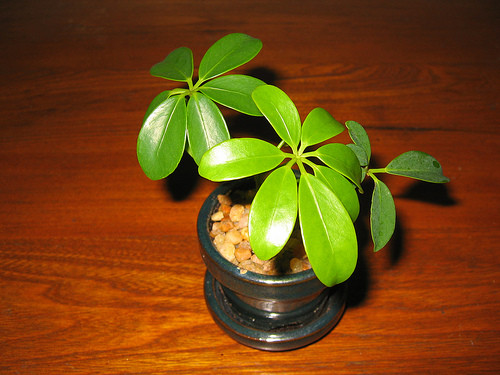 However, it is important to remember:In order for the Schefflera radiantifolia to look good and delight us with its beauty, you should constantly take care of the cleanliness of its leaves, periodically wiping them with a dry soft cloth - this gives them a very pleasant soft shine. Although Schefflera belongs to the Araliaceae group, which includes such famous medicinal plants as ginseng, aralia and others, scientists have not yet discovered any medicinal compounds in this plant, but they believe that it is already very valuable for neutralizing harmful substances and humidifying the air. It should also be remembered that the plant juice of the Schefflera radiantifolia contains compounds that irritate the skin and mucous membrane. For this reason, you should be careful when pruning and cutting the plant, and do not place it in an apartment if there are small children. Let me also remind you that if the soil substrate is over-moistened or there are sharp temperature fluctuations in the room (as well as at too high a temperature in the summer), the leaves may fall off. Weak growth of the plant or yellowing of its leaves may be the result of a lack of nutrients. From time to time, it is necessary to carefully check, especially if the plant was outdoors in the summer, for pests. When buying a schefflera in a store, you should also carefully examine it to make sure that it is not affected by mealybugs, scale insects, aphids or mites. If these pests are present, it is better to refuse to buy such a specimen. It is known that aphids greatly damage and deform young leaves, and spider mites cause their yellowing and drying out, which leads to premature loss of leaves. If you find these pests on the schefflera at home, then use insecticides. Against mites (they often appear in very dry air), spray 2-3 times with a 0.1% solution of neoron (at intervals of 7-10 days), and against scale insects, aphids and mealybugs - 0.2% solution of actellic. Before spraying, the plant is watered abundantly. The air temperature during treatments should not be below 20°C. I will add that sometimes plants are sold whose leaves are covered with a special shiny composition - "polish" - to enhance the decorative effect. However, there is information that such a composition somewhat complicates the activity of the stomata and reduces foliage respiration. Somewhat less often, you can find on sale the tree-like shefflera (S. arboricola), which is characterized by smaller elliptical leathery leaves than the shefflera radiant. The whole plant looks more compact. Now this species is represented by a fairly wide variety of varieties, both with green and with variously colored leaves: Compacta, Melanyla, Soleil, Gold Capella, Green Capella, Compacta and others. In indoor floriculture, Schefflera octophylla with bright veins on the leaves and Schefflera digitata are also cultivated. Schefflera octophylla from East Asia (Taiwan Island) is a small evergreen tree or shrub with an openwork crown covered with palmately compound leaves on long petioles. It has 6-8 elliptical leaflets (7-15 cm long, 2.5-5 cm wide) on small (1-2 cm) petioles.
However, it is important to remember:In order for the Schefflera radiantifolia to look good and delight us with its beauty, you should constantly take care of the cleanliness of its leaves, periodically wiping them with a dry soft cloth - this gives them a very pleasant soft shine. Although Schefflera belongs to the Araliaceae group, which includes such famous medicinal plants as ginseng, aralia and others, scientists have not yet discovered any medicinal compounds in this plant, but they believe that it is already very valuable for neutralizing harmful substances and humidifying the air. It should also be remembered that the plant juice of the Schefflera radiantifolia contains compounds that irritate the skin and mucous membrane. For this reason, you should be careful when pruning and cutting the plant, and do not place it in an apartment if there are small children. Let me also remind you that if the soil substrate is over-moistened or there are sharp temperature fluctuations in the room (as well as at too high a temperature in the summer), the leaves may fall off. Weak growth of the plant or yellowing of its leaves may be the result of a lack of nutrients. From time to time, it is necessary to carefully check, especially if the plant was outdoors in the summer, for pests. When buying a schefflera in a store, you should also carefully examine it to make sure that it is not affected by mealybugs, scale insects, aphids or mites. If these pests are present, it is better to refuse to buy such a specimen. It is known that aphids greatly damage and deform young leaves, and spider mites cause their yellowing and drying out, which leads to premature loss of leaves. If you find these pests on the schefflera at home, then use insecticides. Against mites (they often appear in very dry air), spray 2-3 times with a 0.1% solution of neoron (at intervals of 7-10 days), and against scale insects, aphids and mealybugs - 0.2% solution of actellic. Before spraying, the plant is watered abundantly. The air temperature during treatments should not be below 20°C. I will add that sometimes plants are sold whose leaves are covered with a special shiny composition - "polish" - to enhance the decorative effect. However, there is information that such a composition somewhat complicates the activity of the stomata and reduces foliage respiration. Somewhat less often, you can find on sale the tree-like shefflera (S. arboricola), which is characterized by smaller elliptical leathery leaves than the shefflera radiant. The whole plant looks more compact. Now this species is represented by a fairly wide variety of varieties, both with green and with variously colored leaves: Compacta, Melanyla, Soleil, Gold Capella, Green Capella, Compacta and others. In indoor floriculture, Schefflera octophylla with bright veins on the leaves and Schefflera digitata are also cultivated. Schefflera octophylla from East Asia (Taiwan Island) is a small evergreen tree or shrub with an openwork crown covered with palmately compound leaves on long petioles. It has 6-8 elliptical leaflets (7-15 cm long, 2.5-5 cm wide) on small (1-2 cm) petioles.

Making Money with Desserts: Success Stories
Evgeniya Polischuk (Fedutinova) instagram:@evgeniyafedutinovavk.com/janeshomebaking– It all started with baking for family and friends. Gradually, I started posting photos of my baked goods on Instagram – and orders started coming in. I made my first custom-made cake on October 13, 2014, and a little earlier I started making macaroons and cupcakes. You could say that the business “found me”, I am very […]

Soups are cold recipes with photos
Cold cucumber soup with yogurt and lemonsorbet from the chef of the restaurant La Taverna Alexander Zhurkin Photo: Getty Images Ingredients: Plain yoghurt – 125 g Cucumber – 150 g Lemon/lime sorbet – 50 g Cocktail shrimp – 24 g Fresh ginger juice – 1 g Lime juice – 5 g Fresh orange juice – 5 g Parsley – 1 g Pink pepper – 1 g Watercress – […]

barbeque kebab
Pork tenderloin in glaze Photo:Dmitry Bayrak/dbstudioPreparation time: 20 minutes + marinating time.Calories: 454 kcal per serving.For 4 servings: 4 pork tenderloins (approximately 300 g each), 1 onion, 2 cloves of garlic, 1 tsp. lemon zest, 1 tsp. lemon juice, a pinch of ground cumin, coriander and turmeric, 1 tbsp. vegetable […]

Pierre Duacan: dietary recipes: Ducane diet
Beetroot soup Photo:Season’S, Luxury Hotels RepresentationYou will need:· Boiled beetroot – 60 g· Fresh cucumbers – 20 g· Red radish – 20 g· Green onions – 10 g· Egg – 1 pc.· Drinking mineral water – 200 g· Salt – 1 gPreparation:· Boil the egg and beetroot.· Grate the cucumbers, radish and part of the beetroot. Put everything […]
